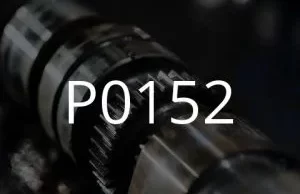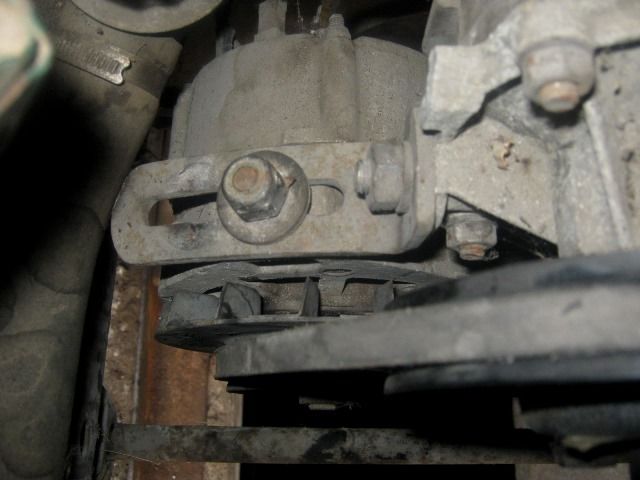
P0152 O1 Sensor Circuit High Voltage (Sensor 2, Bank XNUMX)
Content
P0152 – OBD-II Trouble Code Technical Description
Trouble code P0152 indicates a high voltage in the oxygen sensor 1 (bank 2) circuit.
What does the fault code mean P0152?
Trouble code P0152 indicates that the engine control module (ECM) has detected that the oxygen sensor 1 (bank 2) circuit voltage is greater than 1,2 volts for more than 10 seconds. This may indicate an insufficient amount of oxygen in the exhaust gases or a short circuit to the on-board network in the sensor circuit.

Possible reasons
Some possible causes for the P0152 code:
- Defective oxygen sensor: The oxygen sensor may be faulty, malfunctioning, or damaged, resulting in incorrect or unreliable exhaust gas oxygen readings.
- Problems with wiring and connections: Opens, corrosion, or poor connections in the wiring or connectors connecting the oxygen sensor to the engine control module (ECM) can cause the P0152 code.
- Problems with power or grounding of the oxygen sensor: Improper power supply or grounding of the oxygen sensor can result in incorrect sensor readings and therefore a P0152 code.
- Malfunctions in the engine control module (ECM): Problems with the engine control module, which processes signals from the oxygen sensor, can also cause P0152.
- Problems with the exhaust system or fuel injection system: Some problems with the exhaust system or fuel injection system can affect the performance of the oxygen sensor and cause the P0152 code.
- Incorrect installation of the oxygen sensor: Improper installation of the oxygen sensor, such as too close to a hot source such as the exhaust system, can also cause P0152.
This is only a general list of possible causes, and the specific cause of the P0152 code can only be determined after detailed diagnostics.
What are the symptoms of a fault code? P0152?
Symptoms for a P0152 trouble code can be varied and may vary depending on the specific cause of the fault, vehicle characteristics and operating conditions, some of the possible symptoms are:
- Increased fuel consumption: A faulty oxygen sensor can result in an incorrect mixture of fuel and air, which can result in increased fuel consumption.
- Loss of power: A faulty oxygen sensor can cause suboptimal engine performance, which can result in loss of power and vehicle performance.
- Unstable idle: An improper fuel/air mixture caused by a faulty oxygen sensor can cause rough idling or even misfire.
- High emissions of harmful substances: Improper fuel/air mixture due to a faulty oxygen sensor can increase exhaust emissions of harmful substances such as nitrogen oxides (NOx) and hydrocarbons (HC).
- Black smoke from the exhaust system: If there is excessive fuel supply due to a faulty oxygen sensor, excessive fuel combustion may occur, resulting in black smoke in the exhaust system.
- Error on the dashboard (Check Engine Light): One of the most obvious symptoms is the appearance of an error on the dashboard, signaling a problem with the oxygen sensor.
- Unstable engine operation on a cold start: During a cold engine start, a faulty oxygen sensor can cause problems with initial idle speed and engine stability.
It is important to remember that not all symptoms will necessarily occur at the same time or at the same time as the P0152 code. If you suspect an issue with your oxygen sensor or receive this error code, it is recommended that you have your vehicle diagnosed and repaired by a qualified mechanic.
How to diagnose a fault code P0152?
To diagnose DTC P0152, follow these steps:
- Checking the error code: Use a diagnostic scan tool to read the error code from the Engine Control Module (ECM). Verify that the P0152 code is indeed present.
- Checking connections and wiring: Check the condition of the wiring and connectors connecting the oxygen sensor to the ECM. Pay attention to the presence of corrosion, breaks or distortions.
- Checking the oxygen sensor voltage: Use a multimeter to check the voltage at the oxygen sensor output terminals. The voltage must vary within a certain range when the engine is running.
- Checking power and grounding: Make sure the oxygen sensor is receiving proper power and ground. Check the voltage on the corresponding contacts.
- Engine Control Module (ECM) Diagnosis: If necessary, perform diagnostics on the ECM to check its operation and processing of signals from the oxygen sensor.
- Checking the exhaust system and fuel injection system: Check the condition of the exhaust system and fuel injection system for possible problems that may affect the operation of the oxygen sensor.
- Additional tests and inspections: Perform additional tests and inspections as necessary, such as checking the engine in various modes or using specialized equipment to diagnose the oxygen sensor.
After diagnosing and determining the specific cause of the P0152 code, make the necessary repairs or replace the faulty components. If you are inexperienced or do not have the necessary equipment, it is recommended that you have your vehicle diagnosed and repaired by a qualified mechanic or authorized service center.
Diagnostic errors
When diagnosing the P0152 trouble code, various errors can occur that can make it difficult or misinterpret the problem. Below are some of the possible errors:
- Incorrect interpretation of oxygen sensor data: Interpretation of data received from the oxygen sensor may be inaccurate or incorrect, which may lead to an incorrect diagnosis of the problem.
- Insufficient diagnosis: Incomplete or incorrect tests and diagnostic procedures may result in missing important factors affecting oxygen sensor performance.
- Improper handling of wiring and connectors: Improper handling of wiring and connectors, such as accidentally disconnecting or damaging wires, can cause additional problems and create new errors.
- Ignoring other potential causes: Focusing only on the oxygen sensor without considering other possible causes of the P0152 code, such as problems with the exhaust system or fuel injection system, can lead to important details being missed.
- Poor decision to repair or replace components: Making the wrong decision to repair or replace components without sufficient diagnosis and analysis can result in additional repair costs and ineffective resolution of the problem.
- No software updates: Some errors may be caused by problems in the engine control module software, and ignoring this aspect may also lead to an incorrect diagnosis.
To avoid these mistakes, it is important to follow professional diagnostic techniques, use the correct equipment, perform tests in accordance with the manufacturer's recommendations and, if necessary, contact an experienced technician for help and advice.
How serious is the fault code? P0152?
The severity of the P0152 trouble code may vary depending on the specific cause and vehicle operating conditions. Several aspects that determine the severity of this problem:
- Impact on emissions: A faulty oxygen sensor can result in an incorrect fuel/air mixture, which can increase exhaust emissions. This can lead to emissions problems and non-compliance with environmental regulations.
- Loss of power and efficiency: A faulty oxygen sensor can cause the engine to perform less than optimally, which can result in loss of power and increased fuel consumption.
- Influence on engine performance: Incorrect operation of the oxygen sensor can affect engine performance, including engine stability and smoothness. This can lead to rough idling and other problems.
- Possibility of catalytic converter damage: Continued operation with a faulty oxygen sensor may cause damage to the catalytic converter due to improper fuel/air mixture or excess fuel in the exhaust gases.
- Unpredictability of vehicle performance: A faulty oxygen sensor can cause abnormalities in the vehicle's performance, making it less predictable and controllable.
Based on these factors, Trouble Code P0152 should be considered a serious issue that could affect the safety, performance, and reliability of your vehicle. Therefore, it is recommended to carry out diagnosis and repair as soon as possible to avoid further problems.
What repair will help eliminate the code? P0152?
Trouble code P0152 may require the following steps to resolve:
- Replacing the oxygen sensor: If the oxygen sensor is truly faulty or has failed, replacing it with a new, working one may be the most effective way to resolve the P0152 code. Make sure the oxygen sensor you are replacing meets your specific vehicle's specifications.
- Checking and replacing wiring and connectors: Check the condition of the wiring, connections and connectors associated with the oxygen sensor. Poor connections or breaks can cause the P0152 code. If necessary, replace damaged wires or connectors.
- Checking power and grounding: Make sure the oxygen sensor is receiving proper power and ground. Check the voltage on the corresponding contacts.
- Engine Control Module (ECM) Diagnostics and Repair: In some cases, the problem may be due to a faulty engine control module. In this case, the ECM may need to be diagnosed and, if necessary, repaired or replaced.
- Checking the exhaust system and fuel injection system: Malfunctions in the exhaust system or fuel injection system can also cause P0152. Check the condition of these systems and make any necessary repairs or replacements.
- Updating the software: Sometimes the problem can be solved by updating the engine control module software.
The specific repair chosen will depend on the cause of the P0152 code, which must be determined during the diagnostic process. If you are unsure of your skills or experience, it is recommended that you have your vehicle diagnosed and repaired by a qualified mechanic or authorized service center.
P0152 – Brand-specific information
Trouble code P0152 indicates a problem with the Oxygen Sensor on circuit 2, bank 2. Below are the codes for some specific vehicle brands:
- Volkswagen (VW): P0152 – “Oxygen Sensor Circuit High Voltage (Bank 2, Sensor 1)”.
- Ford: P0152 – “Oxygen Sensor Circuit High Voltage (Bank 2 Sensor 1)”.
- Chevrolet / GMC: P0152 – “Oxygen Sensor Circuit High Voltage (Bank 2 Sensor 1)”.
- Toyota: P0152 – “Oxygen Sensor Circuit High Voltage (Bank 2 Sensor 1)”.
- BMW: P0152 – “O2 Sensor Circuit High Voltage (Bank 2 Sensor 1)”.
- Mercedes-Benz: P0152 – “Oxygen Sensor Circuit High Voltage (Bank 2 Sensor 1)”.
- Audi: P0152 – “Oxygen Sensor Circuit High Voltage (Bank 2 Sensor 1)”.
- Honda: P0152 – “Oxygen Sensor Circuit High Voltage (Bank 2 Sensor 1)”.
- Hyundai: P0152 – “Oxygen Sensor Circuit High Voltage (Bank 2 Sensor 1)”.
- Nissan: P0152 – “Oxygen Sensor Circuit High Voltage (Bank 2 Sensor 1)”.
These explanations may vary slightly depending on the model and year of the car, but the basic meaning remains the same: a problem with high voltage on the oxygen sensor in the second bank (Bank 2 Sensor 1).
